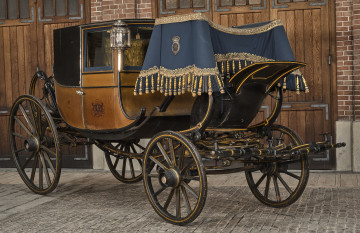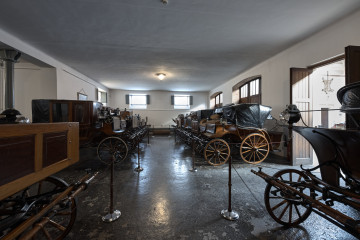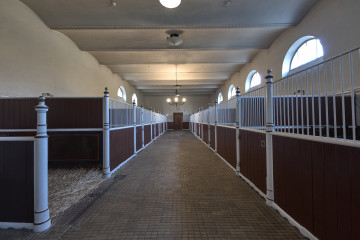
Couépe De Gala
1844 — 1850
Castle Museum in Łańcut
Part of the collection: Pojazdy i uprzęże
A dormeuse is a sleeper carriage, for two persons, drawn by four horses, from ca. mid 19th century, produced in Austria by an unknown carriage manufacturer. A dormeuse (French: sleeping, drowsy) was a 19th century luxury carriage for long expeditions offering extensive leg room and owned exclusively by the rich. Extension of the lower part of the body at the front in the form of a flat boot was characteristic for this type of carriage. In dormeuse carriages driven from the box, the boot was located underneath it. Inside, apart from seats, the dormeuse was provided with tables, mirrors, pockets and a flat suitcase placed on the roof and adjusted to the carriage and forming a set with it. Some dormeuses, apart from the suitcase, also had a fixed chest installed behind the body. In Poland, apart from the Łańcut dormeuse, another one kept in museum collections is a dormeuse in the historical collections of the Działyński and Zamoyski families in the PAN Library in Kórnik. The Kórnik dormeuse belonged to Count Jan Działyński. The European collections feature only few sleeper carriages. Some of them, like the Kórnik dormeuse, are additionally provided with a two-person box for the footmen with a leather roof placed over it. The dormeuse of the Potocki family from Łańcut does not have a chest or the suitcase, but only a broad storage shelf for a coffer placed behind the body. It has a candle light attached to the back wall of the body, which was characteristic for travel carriages, with one window pane fitted to the wall. It illuminates the luxury interior, upholstered with green Saffiano leather. The inside is provided with pockets where items needed during the journey were stored and two stools, fixed below the windows in the front wall, which could have been folded. It is important to note that in the dormeuses such as the Łańcut one, the travellers could sleep lying down or half-lying down with their legs in the flat boot forming the extension of the body. At daytime, bed linen was stored there. Thanks to it, it was possible to travel non-stop only changing horses at intervals of twenty kilometres or so. From Łańcut to Paris, such journey lasted 17 days. Aldona Cholewianka-Kruszyńska
Other names
Travel carriage
Author / creator
Dimensions
height: 256 cm, width: 184 cm
Object type
Vehicles and harnesses
Technique
installation
Material
glass, leather, metal, wood, cloth
Origin / acquisition method
decyzja administracyjna
Creation time / dating
Creation / finding place
Owner
Castle Museum in Łańcut
Identification number
Location / status

1844 — 1850
Castle Museum in Łańcut

Castle Museum in Łańcut

Castle Museum in Łańcut
DISCOVER this TOPIC
National Museum in Szczecin
DISCOVER this PATH
Educational path